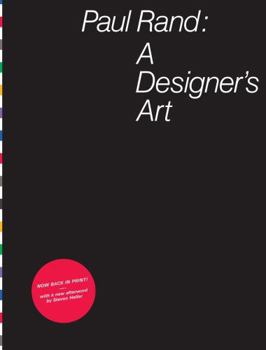Paul Rand: A Designer's Art
Select Format
Select Condition 
Book Overview
If Paul Rand was the most influential American graphic designer of the twentieth century, then Paul Rand: A Designer's Art is the most important on his work. A comprehensive collection of his most important and best-known designs, A Designer's Art gives unique insight into Rand's design process and theory. This new edition of Rand's classic monograph, long unavailable, meticulously re-creates the graphic quality of the original. It includes more than two hundred illustrations and twenty-seven essays, and a new afterword by Steven Heller. This book is required reading for anybody interested in modern design.
Format:Hardcover
Language:English
ISBN:1616894865
ISBN13:9781616894863
Release Date:November 2016
Publisher:Princeton Architectural Press
Length:256 Pages
Weight:2.70 lbs.
Dimensions:1.1" x 7.8" x 10.2"
Customer Reviews
5 ratings
Beautiful Paul Rand
Published by Thriftbooks.com User , 16 years ago
A gorgeous and thorough documentation -- both written and visual -- of Paul Rand.
A Designer's Inspiration
Published by Thriftbooks.com User , 20 years ago
Reading Paul Rand's book "A Designer's Art" should be a source of inspiration for anyone who considers him- or herself a designer -- in any medium. At least, it was definitely an inspiration for me. I didn't expect to get much out of it when I started it, frankly. Part of that feeling is attributable to the fact that I didn't know Rand's work as well as I should. I had heard the name, but did not know what he had done. As the book began, and I figured out that he is, in a large way, responsible for the corporate identity of some pretty big names (IBM, Westinghouse, and UPS among them), and is capable of working in multiple media, both two-dimensional and three-dimensional, I found myself respecting him. As it continued and he showed himself to be not only a very creative designer, but also a thoughtful analyst and an excellent communicator, I found myself agreeing with most of what he had to say. As the book concluded, I found myself inspired in my own work by what he pointed out. "A Designer's Art" is everything its title implies... it is about good design and it is about compelling art. The two, while not necessarily the same, are definitely fused together in many ways. Artistic disciplines and methods and trends affect design work to a large extent, while principles of good design can also be applied to the basic creative process one goes through when making a more purely artistic endeavour. Particularly compelling in this regard was the chapter near the end of the book, about the benefits of the "play instinct" and how it applies to design. By discussing several games and ways of playing with visual relationships, such as tangrams, tatami (the arranging of floor mats), Le Corbusier's "Modulor," and the creation of Chinese characters, Rand discusses several games and how they can be used in the design process, either in the solution for a specific problem, or as tasks in and of themselves. These "games" help to teach the designer to look at visual presentations in a different way, to see tired concepts in a new light, and to use originality to think their way around a problem. Like directed play does for children, visual games help to discipline the mind to see through what is presented and into an original way of looking at the same thing. "The student learns to conceptualize, to associate, to make analogies," he says. "To see a sphere, for example, transformed into an orange, or a button into a letter, or a group of letters into a broad picture." Also very interesting was his discussion of the color black, reclaiming it for new audiences and new purposes, and his thoughts on including a sense of humor or wit in your designs. His conclusion is where I really came to admire this book, though, as he relies on the words of one of his employers: "Good design at heart is simply honesty. It is an ingredient of character. Good design helps to form in any one part of the business an influence that affects all part of the business. It sust
Paul Rand: A Designer's Must Have
Published by Thriftbooks.com User , 21 years ago
The single greatest book on Graphic Design ever written. This is not a tutorial or a how to, but a why. Why things work, why they don't, and why it is important to know about its history. Learn the importance of this medium, its impact on industry, and its place in the arts. "That graphic design is generally considered a minor art has more to do with posturing than it does with reality." -Paul Rand
NON LIKE ANY OTHER
Published by Thriftbooks.com User , 22 years ago
I don't want my competitors to read this. It gives me the edge in designing.
content designer content book [full of ideas]no decorationss
Published by Thriftbooks.com User , 25 years ago
a book to keep for designers. heavy with ideas and great graphics. having known paul rand and being inspired by him the book also presented some graphics i have not seen as it was before my time. a book to refer to about design in general. solid text and research. miho





